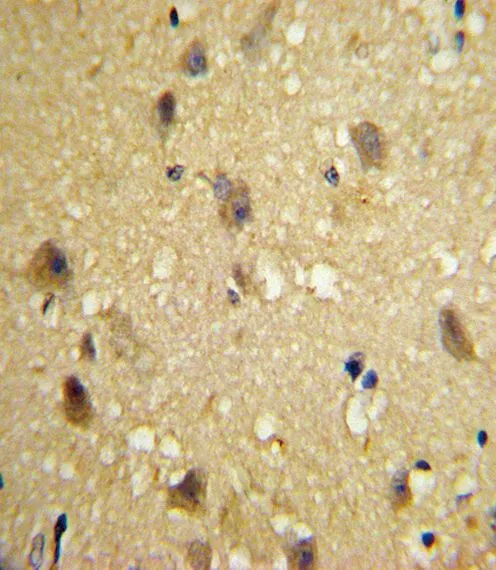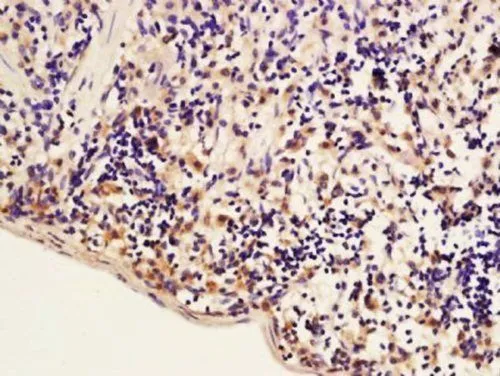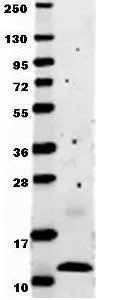![ELISA analysis of antigen using GTX60582 MCP1 / CCL2 antibody [2D8]. Black : Control antigen 100ng Purple : Antigen 10ng Blue : Antigen 50ng Red : Antigen 100ng ELISA analysis of antigen using GTX60582 MCP1 / CCL2 antibody [2D8]. Black : Control antigen 100ng Purple : Antigen 10ng Blue : Antigen 50ng Red : Antigen 100ng](https://www.genetex.com/upload/website/prouct_img/normal/GTX60582/GTX60582_20170912_ELISA_w_23061123_196.webp)
ELISA analysis of antigen using GTX60582 MCP1 / CCL2 antibody [2D8]. Black : Control antigen 100ng Purple : Antigen 10ng Blue : Antigen 50ng Red : Antigen 100ng
MCP1 / CCL2 antibody [2D8]
GTX60582
ApplicationsFlow Cytometry, ImmunoFluorescence, Western Blot, ELISA, ImmunoCytoChemistry, ImmunoHistoChemistry, ImmunoHistoChemistry Frozen, ImmunoHistoChemistry Paraffin
Product group Antibodies
TargetCCL2
Overview
- SupplierGeneTex
- Product NameMCP1 / CCL2 antibody [2D8]
- Delivery Days Customer9
- Application Supplier NoteWB: 1/500 - 1/2000. ICC/IF: 1/200 - 1/1000. IHC-P: 1/200 - 1/1000. FACS: 1/200 - 1/400. ELISA: 1/10000. *Optimal dilutions/concentrations should be determined by the researcher.Not tested in other applications.
- ApplicationsFlow Cytometry, ImmunoFluorescence, Western Blot, ELISA, ImmunoCytoChemistry, ImmunoHistoChemistry, ImmunoHistoChemistry Frozen, ImmunoHistoChemistry Paraffin
- CertificationResearch Use Only
- ClonalityMonoclonal
- Clone ID2D8
- Concentration1 mg/ml
- ConjugateUnconjugated
- Gene ID6347
- Target nameCCL2
- Target descriptionC-C motif chemokine ligand 2
- Target synonymsGDCF-2, HC11, HSMCR30, MCAF, MCP-1, MCP1, SCYA2, SMC-CF, C-C motif chemokine 2, chemokine (C-C motif) ligand 2, monocyte chemoattractant protein-1, monocyte chemotactic and activating factor, monocyte chemotactic protein 1, monocyte secretory protein JE, small inducible cytokine A2 (monocyte chemotactic protein 1, homologous to mouse Sig-je), small inducible cytokine subfamily A (Cys-Cys), member 2, small-inducible cytokine A2
- HostMouse
- IsotypeIgG1
- Protein IDP13500
- Protein NameC-C motif chemokine 2
- Scientific DescriptionThis gene is one of several cytokine genes clustered on the q-arm of chromosome 17. Cytokines are a family of secreted proteins involved in immunoregulatory and inflammatory processes. The protein encoded by this gene is structurally related to the CXC subfamily of cytokines. Members of this subfamily are characterized by two cysteines separated by a single amino acid. This cytokine displays chemotactic activity for monocytes and basophils but not for neutrophils or eosinophils. It has been implicated in the pathogenesis of diseases characterized by monocytic infiltrates, like psoriasis, rheumatoid arthritis and atherosclerosis. It binds to chemokine receptors CCR2 and CCR4. [provided by RefSeq, Jul 2008]
- Storage Instruction-20°C or -80°C,2°C to 8°C
- UNSPSC12352203
References
- Chronic Intermittent Hypoxia Regulates CaMKII-Dependent MAPK Signaling to Promote the Initiation of Abdominal Aortic Aneurysm. Xu C et al., 2021, Oxid Med Cell LongevRead more
- Granulocyte Colony Stimulating Factor (GCSF) Can Attenuate Neuropathic Pain by Suppressing Monocyte Chemoattractant Protein-1 (MCP-1) Expression, through Upregulating the Early MicroRNA-122 Expression in the Dorsal Root Ganglia. Liao MF et al., 2020 Jul 11, CellsRead more
- Endogenous production of C-C motif chemokine ligand 2 by nasopharyngeal carcinoma cells drives radioresistance-associated metastasis. Guo SS et al., 2020 Jan 1, Cancer LettRead more
- Recovery From a Myocardial Infarction Is Impaired in Male C57bl/6 N Mice Acutely Exposed to the Bisphenols and Phthalates That Escape From Medical Devices Used in Cardiac Surgery. Shang J et al., 2019 Mar 1, Toxicol SciRead more
- TIM-4 blockade of KCs combined with exogenous TGF-beta injection helps to reverse acute rejection and prolong the survival rate of mice receiving liver allografts. Wu H et al., 2018 Jul, Int J Mol MedRead more
- Neuronal CCL2 is upregulated during hepatic encephalopathy and contributes to microglia activation and neurological decline. McMillin M et al., 2014 Jul 10, J NeuroinflammationRead more

![FACS analysis of A549 cells using GTX60582 MCP1 / CCL2 antibody [2D8]. Green : MCP1 / CCL2 Red : negative control FACS analysis of A549 cells using GTX60582 MCP1 / CCL2 antibody [2D8]. Green : MCP1 / CCL2 Red : negative control](https://www.genetex.com/upload/website/prouct_img/normal/GTX60582/GTX60582_20170912_FACS_w_23061123_799.webp)
![ICC/IF analysis of HepG2 cells using GTX60582 MCP1 / CCL2 antibody [2D8]. Green : MCP1 / CCL2 Blue: DRAQ5 fluorescent DNA dye Red: Actin filaments ICC/IF analysis of HepG2 cells using GTX60582 MCP1 / CCL2 antibody [2D8]. Green : MCP1 / CCL2 Blue: DRAQ5 fluorescent DNA dye Red: Actin filaments](https://www.genetex.com/upload/website/prouct_img/normal/GTX60582/GTX60582_20170912_ICCIF_w_23061123_564.webp)
![IHC-P analysis of human liver cancer tissue using GTX60582 MCP1 / CCL2 antibody [2D8]. IHC-P analysis of human liver cancer tissue using GTX60582 MCP1 / CCL2 antibody [2D8].](https://www.genetex.com/upload/website/prouct_img/normal/GTX60582/GTX60582_20170912_IHC-P_w_23061123_972.webp)
![WB analysis of human CCL2 (AA: 1-99) recombinant protein using GTX60582 MCP1 / CCL2 antibody [2D8]. WB analysis of human CCL2 (AA: 1-99) recombinant protein using GTX60582 MCP1 / CCL2 antibody [2D8].](https://www.genetex.com/upload/website/prouct_img/normal/GTX60582/GTX60582_20170912_WB_1_w_23061123_220.webp)
![WB analysis of A549 (1), HeLa (2), Raw264.7 (3), L1210 (4), C6 (5), and COS-7 (6) using GTX60582 MCP1 / CCL2 antibody [2D8]. WB analysis of A549 (1), HeLa (2), Raw264.7 (3), L1210 (4), C6 (5), and COS-7 (6) using GTX60582 MCP1 / CCL2 antibody [2D8].](https://www.genetex.com/upload/website/prouct_img/normal/GTX60582/GTX60582_20170912_WB_w_23061123_911.webp)
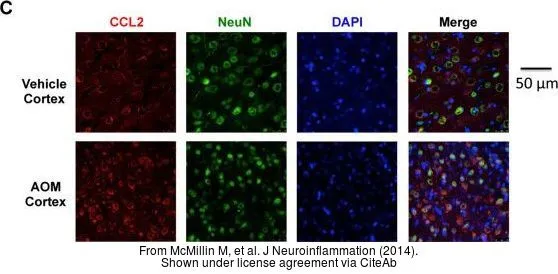
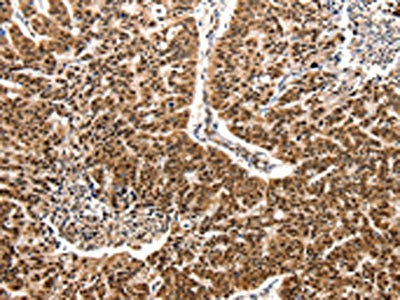
![WB analysis of tissue extracts (30 microg lysate) of Mouse Pancreas (Lane 1), Spleen (Lane 2), Lung (Lane 3) and Cerebellum (Lane 4) using GTX15784 MCP1 / CCL2 antibody [E10051]. Dilution : 1-2 microg/ml](https://www.genetex.com/upload/website/prouct_img/normal/GTX15784/GTX15784_1536_WB_w_23060620_978.webp)
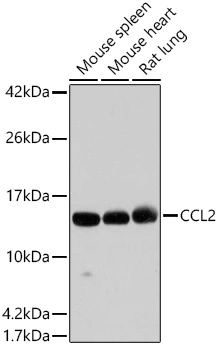
![WB analysis of truncated MCP-1 recombinant protein using GTX83238 MCP1 / CCL2 antibody [1A7B8].](https://www.genetex.com/upload/website/prouct_img/normal/GTX83238/GTX83238_20170912_WB_w_23061322_173.webp)
